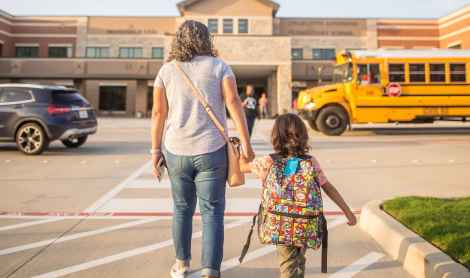Agency. Acceleration. Autonomy.
You couldn’t miss these words, prominently displayed throughout the school. But these were not just words on walls: I saw how students, teachers, and administrators took those beliefs seriously. As I walked through the hallways, I saw students in classrooms focused on their work to accelerate progress towards their goals. Some were in independent study rooms, some in classroom pods, and others coming and going from classes at a local community college.
I spoke with two student ambassadors and heard why they choose this high school: the opportunity to earn college credits; the ability to be themselves; a small and family-like atmosphere;, and the desire to “blaze their own trail.” They also talked about what made the school a great fit, pointing to teachers that “won’t let me slack off…but I know it comes from a place of love,” the ability to earn more privileges and freedoms as they mature, and the importance of the morning “village” check-in.
The school’s leadership pointed to impressive outcomes, including strong student attendance among what they call “underestimated youth;” impressive gains in SAT scores; 100 percent of their remarkably diverse instructional staff returning for a second year; and that in just two years, students earned a total of 314 college credits, saving nearly $100,000 towards a traditional in-state four-year tuition.
They spoke about how hard, yet necessary, it was to begin this new school during the pandemic, and their desire to serve more students when the opportunity arises.
Those are just a few moments from my visit to Believe Circle City High School in Indianapolis earlier this year. To me, they illustrate why we together seek excellence in our efforts. Seeing schools like Believe makes me double-down on our commitment to Excellence from Communities—NACSA’s approach to quality authorizing that leads to sustainable, equitable, innovative, high-quality educational opportunities led by more people with ties to the lived experiences of historically under-resourced communities.
But it’s not just words for us; we’ve put action behind our commitments:
-
Our State of Charter Authorizing Report bridges the gap between where authorizing is and the future we envision.
-
Multiple Measures—the future of school accountability, and more important than ever, as I wrote about in this piece—offers resources to help authorizers and schools partner on this transformational work.
-
We’re elevating the profession of authorizing to a more diverse audience as we seek to diversify authorizing. Through a recent social media campaign, we’ve reached more than 70,000 people on what is authorizing and the impact it can have.
-
At this fall’s NACSACon 2022—Excellence from Communities, with more than 500 attendees and 60 sessions, the conversations and exchange of ideas energized us all. And the conversation is continuing!
Our commitment continues too. We want to ensure kids recover well from the ravages of the pandemic and move into thriving. So, we’re going to keep to pushing for the replication and expansion of high-quality charter schools that advance student learning and wellness, and close opportunity and achievement gaps. We’re also going to keep pushing for new and innovative ways of organizing learning, governed and led by people of color and those with deep ties to local communities.
I am grateful that we don’t do this work alone. Each of you has engaged with us; we are excited to build on the momentum we’ve created together. As the year closes, my hope for each of you is time for reflection, rejuvenation, and renewal.
Well wishes,
Karega Rausch, PhD


